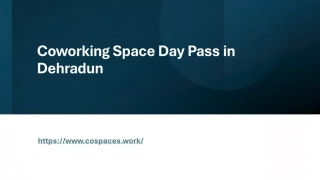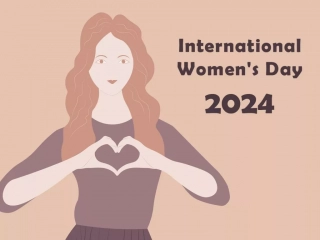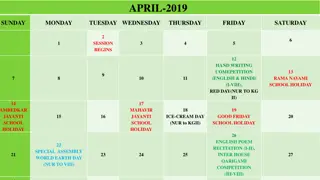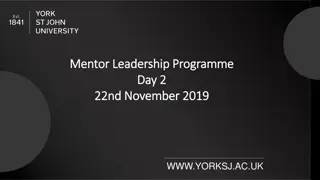
Title IX Regulations and Sexual Harassment Policies in Schools
Learn about Title IX regulations, the role of Title IX Coordinator, and the definition of sexual harassment in educational settings. Discover how schools are required to handle complaints and promote equity in addressing sex discrimination.
Uploaded on | 1 Views
Download Presentation

Please find below an Image/Link to download the presentation.
The content on the website is provided AS IS for your information and personal use only. It may not be sold, licensed, or shared on other websites without obtaining consent from the author. If you encounter any issues during the download, it is possible that the publisher has removed the file from their server.
You are allowed to download the files provided on this website for personal or commercial use, subject to the condition that they are used lawfully. All files are the property of their respective owners.
The content on the website is provided AS IS for your information and personal use only. It may not be sold, licensed, or shared on other websites without obtaining consent from the author.
E N D
Presentation Transcript
Welcome Back! Fennimore Community Schools Back to School Professional Development August 24, 2022 MATT BELL, ATTORNEY
Sex Discrimination Title IX of the Education Amendments Act of 1972: federal civil rights law that prohibits discrimination against students, employees, and other individuals (e.g., third parties, applicants for employment) based on sex in a school district s education programs, activities and operations. Sexual harassment is a form of sex discrimination. Sexual harassment is also prohibited under state and federal law. The District s policy regarding Title IX sexual harassment is Po2266. There is also another policy (5517) with a separate definition of sexual harassment, more on that later.
Title IX Regulations U.S. Department of Education issued new regulations that went into effect August 14, 2020. The new regulations are a change to prior guidance: Sexual harassment is defined in a unique way. Districts are required to: Designate a Title IX Coordinator Respond immediately when any employee has actual knowledge of sexual harassment Adopt and implement a grievance process for formal complaints of sexual harassment (BOE Policy 2266) Ensure all parties involved in complaints are treated equitably Train staff involved in the Title IX process
Title IX Coordinator The District must designate and authorize at least one employee to coordinate its efforts to comply with responsibilities under Title IX. Employee must be referred to as the Title IX Coordinator. District policy identifies Boone Tollefson and Carmen Burkum as your co- Title IX Coordinators
Title IX Coordinator The Title IX Coordinator has primary responsibility for coordinating Title IX compliance efforts, including answering questions about sex discrimination from the school community, responding to reports of sexual harassment, receiving formal complaints, initiating and overseeing the grievance process, and implementing supportive measures and remedies.
Definition of Sexual Harassment Conduct on the basis of sex; That occurs in any education program or activity of the District in the U.S.; and That satisfies one or more of the definitions.
Three-Part Definition of Sexual Harassment A Board employee conditioning the provision of an aid, benefit, or service of the institution on an individual s participation in unwelcome sexual conduct (quid pro quo); or Unwelcome conduct determined by a reasonable person to be so severe, pervasive, and objectively offensive that it effectively denies a person equal access to the institution s education program or activity; or Sexual assault, dating violence, domestic violence or stalking (as defined by law). 1. 2. 3.
Definition of Sexual Harassment Dating violence includes violence committed by a person who has been in a social relationship of a romantic or intimate nature with the complainant; the existence of such a relationship shall be determined based on consideration of the length of the relationship, the type of relationship, and the frequency of interaction between the persons involved in the relationship. Domestic violence includes felony or misdemeanor crimes of violence committed by: a current or former spouse or intimate partner of the complainant, a person with whom the complainant shares a child, a person who is cohabitating with or has cohabitated with the complainant as a spouse or intimate partner, a person similarly situated to a spouse of the complainant under the jurisdiction s domestic or family violence laws, or any other person against a complainant who is protected under the domestic or family violence laws of the jurisdiction. Stalking is defined as engaging in a course of conduct directed at a specific person that would cause a reasonable person to fear for their own safety or the safety of others or to suffer substantial emotional distress. The 2020 amendments cover instances of stalking based on sex including stalking that occurs online or through messaging platforms, commonly known as cyber-stalking when it occurs in the school s education program or activity.
Key Definitions Report of Sexual Harassment Formal Complaint of Sexual Harassment Grievance Procedure The procedure for responding to and resolving reports or complaints of possible unlawful discrimination based on sex under Title IX, other than formal complaints of sexual harassment under Title IX. Grievance Process The highly structured process for investigating and resolving formal complaints of sexual harassment under Title IX.
Triggering the Districts Obligation When the District has actual knowledge of conduct that could constitute sexual harassment under Title IX in an education program or activity of the District, the District must respond promptly in a manner that is not deliberately indifferent. The District is deliberately indifferent only if its response to sexual harassment is clearly unreasonable in light of the known circumstances.
When Does the District Have Actual Knowledge? The District has actual knowledge if notice of sexual harassment or allegations of sexual harassment to the: Title IX Coordinator, or Any District official who has authority to institute corrective measures, or Any Board employee.
Actual Knowledge Examples of ways that the District could obtain actual knowledge of sexual harassment include: o Witnessing an incident (or a perhaps a series of incidents); o Receiving a verbal or written report about an incident or allegation from a student or other person; o Receiving multiple reports that, taken together, provide a different picture of a person s conduct than each incident standing alone; or o The filing of a formal complaint or any report under the District s Title IX grievance procedure or grievance process.
When is Sexual Harassment in a Program or Activity of the District? Includes locations, events, or circumstances over which the District exercised substantial control over both the respondent and the context in which the sexual harassment occurs. May wish to examine factors such as whether the recipient funded, promoted, or sponsored the event or circumstance where the alleged harassment occurred. However, no single factor is determinative to conclude whether a recipient exercised substantial control over the respondent and the context in which the harassment occurred.
Online Sexual Harassment The statutory and regulatory definitions of program or activity encompass all of the operations of such recipients, and such operations may certainly include computer and internet networks, digital platforms, and computer hardware or software owned or operated by, or used in the operations of, the recipient. An education program or activity includes circumstances over which the recipient exercised substantial control over both the respondent and the context in which the harassment occurred, such that the factual circumstances of online harassment must be analyzed to determine if it occurred in an education program or activity. For example, a student using a personal device to perpetrate online sexual harassment during class time or a student harassing in a chat box during a virtual lesson may constitute a circumstance over which the recipient exercises substantial control.
Reporting Sexual Harassment District employees are obligated to report incidents of sexual harassment Any person may report sex discrimination, including sexual harassment. Any person may report in person, by mail, by telephone or by email, using the contact information listed for the Title IX Coordinator, or by any other means that results in the Title IX Coordinator receiving the person s oral or written report. Employees do not need to determine whether the conduct constitutes sexual harassment under Title IX or other state or federal laws. The administration will make that decision.
The Districts Obligation to Respond When the District has actual knowledge of sexual harassment, the Title IX Coordinator must promptly: Contact the alleged victim to discuss the availability of supportive measures and consider the alleged victim s wishes with respect to supportive measures; Explain to the alleged victim the process for filing a formal complaint; Explain the availability of supportive measures with or without filing a formal complaint; Ensure provision of desired supportive services that do not unreasonably burden any party. Ensure both parties are treated equally and apply a presumption that the accused is not responsible for the conduct until a determination is made following the grievance process.
Title IX Removal Procedures Title IX allows for an emergency removal of a student if the student poses a threat to the physical safety of the alleged victim or others. Title IX allows the District to put an employee on administrative leave pending the completion of the grievance process.
Emergency Removal Be careful about using an emergency removal: Must first conduct an individualized safety and risk analysis to determine whether the student Respondent poses an immediate threat to the physical health or safety of any student or other individual arising from the allegations of sexual harassment that justifies removal. Respondent can immediately challenge the removal. When imposing removal, keep in mind IDEA, code of conduct, and suspension/expulsion statutes.
What are Supportive Measures? Designed to restore or preserve equal access to the District s education program or activity without unreasonably burdening the other party. Includes measures designed to protect the safety of all parties and deter sexual harassment. May include counseling, extensions of deadlines or course- related adjustments, modifications of class schedules, mutual restrictions on contact between the parties, changes in work locations, leaves of absence, increased security and monitoring of certain areas, and other similar measures. May not include discipline (e.g., suspension).
When a Formal Complaint is Filed If an alleged victim files a formal complaint of Title IX sexual harassment, then the District must investigate the allegations using its written Title IX grievance process. Investigation Decision Appeal Informal Resolution Each step of the grievance process must be conducted by a different individual who has been trained on Title IX. Title IX Coordinator may be the investigator, but may not be decision-maker or decider of appeal.
Complainant/Respondent Complainant An individual who is alleged to be the victim of conduct that could constitute sexual harassment. The complainant must be participating in or attempting to participate in the education program or activity of the recipient with which the formal complaint is filed. Respondent An individual who has been reported to be the perpetrator of conduct that could constitute sexual harassment.
Formal Complaint Formal complaint means a document filed by a complainant or signed by the Title IX Coordinator alleging sexual harassment against a respondent and requesting that the school investigate the allegation of sexual harassment. A document filed by a complainant means a document that contains the Complainant s physical or digital signature, or otherwise indicates that the Complainant is the person filing the formal complaint. When the Title IX Coordinator signs a formal complaint, the Coordinator does not become the complainant, the victim is still the complainant. When determining whether to sign a formal complaint, Title IX advises that the Coordinator should attempt to understand the complainant s desire regarding the grievance process and take into consideration their wishes. Possible factors to consider may be: the seriousness of the alleged harassment; the age of the student harassed; whether there have been other complaints or reports of harassment against the alleged harasser; whether the alleged perpetrator is in a position of authority. No party, including the complainant can be forced to participate in the grievance process.
Dismissal of Complaint Mandatory Dismissal. The District must dismiss a formal complaint if the conduct alleged in the complaint: Would not constitute sexual harassment as defined under Title IX even if proved; Did not occur in the District s education program or activity; or Did not occur against a person in the U.S. Permissive Dismissal. The District may dismiss if: Complainant notifies of withdrawal of complaint or allegations; Respondent is no longer enrolled or employed by the Board; or Specific circumstances prevent the institution from gathering evidence sufficient to reach a determination.
Grievance Process Basic Tenets: a. Must treat complainants and respondents equitably. b. Provide remedies to a complainant where a determination of responsibility has been made against the respondent. c. Follow a grievance process that complies with this part before the imposition of any disciplinary sanctions or other actions against a respondent. d. Require an objective evaluation of all relevant evidence and provide that credibility determinations may not be based on person s status. e. Require that any individual designated by an institution as a Title IX Coordinator, investigator, decision-maker, or any person designated to facilitate an informal resolution process not have a conflict of interest or bias. f. Include a presumption that the respondent is not responsible for the alleged conduct until a determination of responsibility is made at the conclusion of the grievance process. g. This process may end if at any time the determination is made that the allegations do not constitute sexual harassment under Title IX, if the complainant wishes to end the process, or if the complainant is no longer enrolled in the District.
Grievance Process Each step handled by different individual(s). Parties and witnesses are not required to participate in the Title IX grievance process. Notice of Complaint to both parties. Investigation: Provide evidence to parties 10 calendar days prior to finalizing investigative report and opportunity for the parties to submit a written response. Determination of Responsibility Decision-maker must first give each party the opportunity to submit written, relevant questions that a party wants asked of any other party or witness. Apply a preponderance of the evidence standard (50% plus a feather) Appeal Regulations require appeals to be offered in only three situations. Informal Resolution Cannot use unless a formal complaint is filed or when employee and student are involved.
Retaliation is Prohibited No individual (or district) may intimidate, threaten, coerce, or discriminate against any individual for the purpose of interfering with any right secured by Title IX, or because the individual has made a report or complaint, testified, assisted, or participated, or refused to participate in any manner in an investigation, proceeding or hearing.
Extracurricular Staff and Title IX Coaches and supervisors of extracurricular activities may have much closer relationships to students than other school staff: You may see and hear about more incidents than others in the school setting. You may be in settings where incidents of sexual harassment are more likely to occur.
Extracurricular Staff and Title IX So, what can you do to protect yourself and your students/athletes: Have the discussion with your students/team/athletes. Sexual harassment will not be tolerated! Hazing, which may include or lead to sexual harassment, will not be tolerated (BOE Policy 5516)!
Extracurricular Staff and Title IX Encourage your athletes to report (see something, say something) Keep in mind, you may be the most trusted adult in that student s life, be open to listening. Be present. Sexual harassment is more likely to occur when students are unsupervised. Do you have adequate supervision in your practice rooms, back stage, locker rooms/changing rooms, on the bus, before/after practices/performances?
Extracurricular Staff and Title IX And remember, you are Board employees, so you have an absolute obligation to report incidents of sexual harassment. Unsure if an incident is sexual harassment? Report! It is the role of the Title IX coordinator to ultimately determine if an incident is sexual harassment. Do not make the error of determining on your own that an incident is not sexual harassment only to have that same incident be later determined to be sexual harassment.
Extracurricular Staff and Title IX If a student/athlete reports something to you and says but don t tell anyone You still have an obligation to report and you should inform the athlete of your obligation. The Title IX coordinator in collaboration with the student/family will ultimately determine whether a formal complaint is filed.
Looking Ahead On June 23, 2022, Department of Education released proposed changes to the Title IX regulations. USDOE will now accept public comment on those regulations (so no changes as of right now, and it may be a while) Some of the potential changes: Additional protections for students with disabilities. Clarification that discrimination on the basis of sex includes discrimination based upon sex stereotypes, sex characteristics, pregnancy, sexual orientation, and gender identity. Allowance for Title IX coordinator to take on additional roles. Greater allowance for informal resolution.
Sexual Harassment: Another Definition Policy 5517 includes another definition of sexual harassment covering conduct that does not fall within the definition of Title IX sexual harassment. That definition is as follows: unwelcome sexual advances, requests for sexual favors, sexually motivated physical conduct or other verbal or physical conduct or communication of a sexual nature when: submission to that conduct or communication is made a term or condition, either explicitly or implicitly, of access to educational opportunities or program; submission or rejection of that conduct or communication by an individual is used as a factor in decisions affecting that individual's education; that conduct or communication has the purpose or effect of substantially or unreasonably interfering with an individual's education, or creating an intimidating, hostile, or offensive educational environment.
Sexual Harassment: Another Definition Policy 5517 includes important prohibitions on staff conduct: a sexual relationship between staff and students is not permissible in any form or under any circumstances, in or out of the workplace, in that it interferes with the educational process and may involve elements of coercion by reason of the relative status of a staff member to a student.
Sexual Harassment: Another Definition Sexual harassment (under this policy) may include inappropriate boundary invasions. hugging, kissing, or other physical contacts with a student; telling sexual jokes to students; engaging in talk containing sexual innuendo or banter with students; talking about sexual topics that are not related to the curriculum; showing pornography to a student; taking an undue interest in a student (i.e. having a "special friend" or a "special relationship"); initiating or extending contact with students beyond the school day for personal purposes;
Sexual Harassment: Another Definition Inappropriate boundary invasions (cont.): using e-mail, text messaging or websites to discuss personal topics or interests with students; giving students rides in the staff member's personal vehicle or taking students on personal outings without administrative approval; invading a student's privacy (e.g. walking in on the student in the bathroom, locker-room, asking about bra sizes or previous sexual experiences); going to a student's home for non-educational purposes; inviting students to the staff member's home without proper chaperones (i.e. another staff member or parent of a student); giving gifts or money to a student for no legitimate educational purpose; accepting gifts or money from a student for no legitimate educational purpose; being overly "touchy" with students;
Sexual Harassment: Another Definition Inappropriate boundary invasions (cont.): favoring certain students by inviting them to come to the classroom at non-class times; getting a student out of class to visit with the staff member; providing advice to or counseling a student regarding a personal problem (i.e. problems related to sexual behavior, substance abuse, mental or physical health, and/or family relationships, etc.), unless properly licensed and authorized to do so; talking to a student about problems that would normally be discussed with adults (i.e. marital issues); being alone with a student behind closed doors without a legitimate educational purpose; telling a student "secrets" and having "secrets" with a student.
Sexual Harassment: Another Definiton If conduct is determined to be sexual harassment under Policy 5517 as opposed to sexual harassment under Policy 2266, the District should follow the complaint procedures under Policy 5517 (more on those later). But how do you know? Recommendation- report to the Title IX Coordinator (who are also your Compliance Officers) and they will sort it out. The most important thing is to report. Absolutely report! The District cannot address issues/concerns if they are unaware of those issues/concerns.
Bullying The District has several policies addressing bullying: 5136.01- Technology Resources and Other Equipment Prevents use of technology to threaten, humiliate, harass, embarrass, or intimidate 5516- Student hazing 2221- Special Observance Days Wednesday of the 4th week in September is Bullying Awareness Day 2260/2260.01- Harassment/Nondiscrimination Dictates that if bullying investigation reveals bullying based upon protected class, harassment policy must be implemented
Bullying Defined Definition of bullying (Policy 5517.01): Deliberate or intentional behavior using words or actions, intended to cause fear, intimidation or harm. May be repeated behavior; (DPI s definition indicates the behavior is repeated, or has the potential to be repeated ) Involves an imbalance of power; (DPI s definition includes real or perceived imbalance ); May be serious enough to negatively impact a student's educational, physical, or emotional well-being
Bullying Defined Definition of bullying (Policy 5517.01) : The behavior may be motivated by an actual or perceived distinguishing characteristic, such as but not limited to: age; national origin; race; ethnicity; religion; gender; gender identity; sexual orientation; physical attributes; physical or mental ability or disability; and social, economic, or family status; however this type of prohibited bullying behavior need not be based on any of those particular or other particular characteristics.
Bullying Defined May include the following types of behavior (Policy 5517.01) : Physical- hitting, kicking, spitting, pushing, pulling, taking and/or damaging personal belongings or extorting money, blocking or impeding student movement, unwelcome physical contact. Verbal-taunting, malicious teasing, insulting, name-calling, making threats Psychological- spreading rumors, manipulating social relationships, coercion, or engaging in social exclusion/shunning, extortion, or intimidation
Bullying Defined Cyber-bullying (Policy 5517.01) -the use of information and communication technologies such as e-mail, cell phone, and pager text messages, instant messaging (IM), defamatory personal web sites, and defamatory online personal polling web sites, to support deliberate, repeated, and hostile behavior by an individual or group, that is intended to harm others. Cyberbullying includes, but is not limited to the following: posting slurs or rumors or other disparaging remarks about a student on a web site or on weblog; sending e-mail or instant messages that are mean or threatening, or so numerous as to drive- up the victim s cell phone bill; using a camera phone to take and send embarrassing photographs of students; posting misleading or fake photographs of students on websites.
Bullying vs. Conflict? BULLYING CONFLICT Imbalance of power Size Disability Popularity Age Repeated acts Seeking power/attention Victim reacts strongly Participants are of similar status, equal power One time incident Not seeking power/attention Equal emotional reaction
Bullying Bullying Procedures (Policy 5517.01): Any student who believes they have been or is the victim of bullying should immediately report the situation to the building principal or assistant principal, or the District Administrator. The student may also report concerns to a teacher or counselor. Complaints against the building principal should be filed with the District Administrator. Complaints against the District Administrator should be filed with the Board President. All school staff members and school officials who observe or become aware of acts of bullying are required to report these acts to the building principal or assistant principal, or the District Administrator. Reports of bullying may be made verbally or in writing and may be made confidentially. A written record of the report, including all pertinent details, will be made by the recipient of the report.
Bullying After receipt of report: Report of bullying shall be investigated promptly. Investigation must include interview of victim of alleged bullying. Best practice would dictate an interview of the bully as well. Note- DPI s model policy requires an interview of the victim of the bullying within one school day Parents of each student involved in the bullying will be notified prior to the conclusion of the investigation.
Bullying After investigation activities: If the investigation finds bullying occurred: Prompt and appropriate remedial and/or disciplinary action that may include: Student discipline (ex. reprimand, suspension, expulsion); Discharge for employees; Exclusion for parents, guests, volunteers, and contractors; Removal from any official position and/or a request to resign for Board members; Referral to law enforcement. Maintain report and confidentiality of the report.
Bullying After investigation activities If a student with a disability: Convene an IEP/Section 504 meeting to determine whether, as a result of the effects of bullying, the student s needs have changed such that the IEP is no longer designed to provide meaningful educational benefit.






















